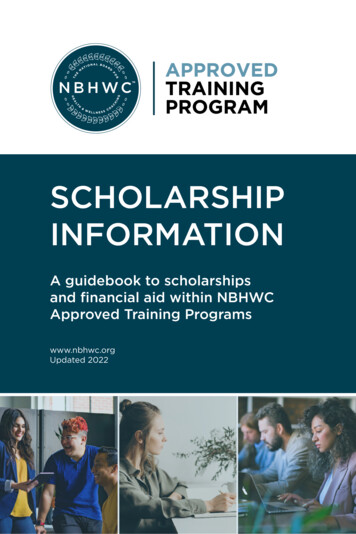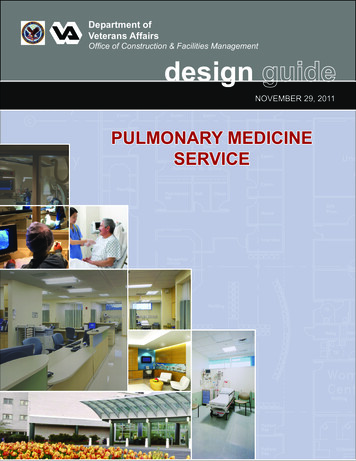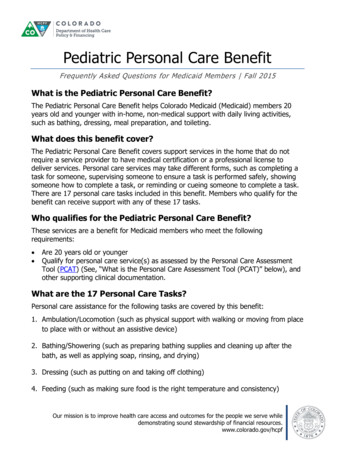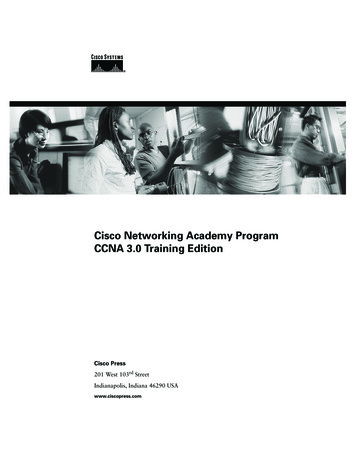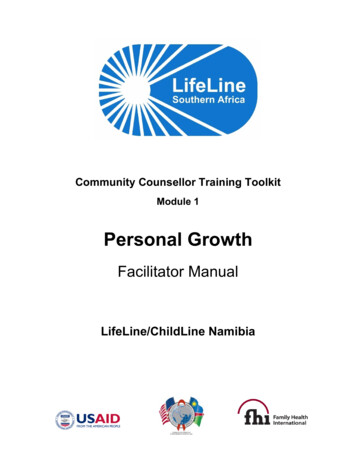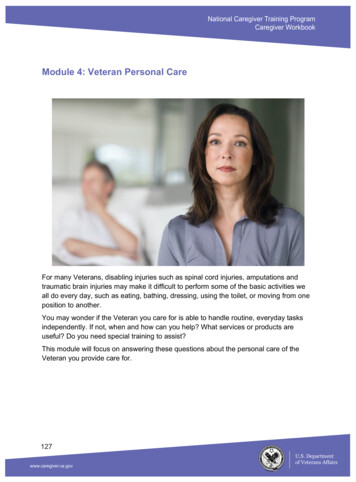
Transcription
National Caregiver Training ProgramNational CaregiverCaregiverTraining WorkbookProgramCaregiver WorkbookModule 4: Veteran Personal CareFor many Veterans, disabling injuries such as spinal cord injuries, amputations andtraumatic brain injuries may make it difficult to perform some of the basic activities weall do every day, such as eating, bathing, dressing, using the toilet, or moving from oneposition to another.You may wonder if the Veteran you care for is able to handle routine, everyday tasksindependently. If not, when and how can you help? What services or products areuseful? Do you need special training to assist?This module will focus on answering these questions about the personal care of theVeteran you provide care U.S. Departmentof Veterans Affairs
National Caregiver Training ProgramNational CaregiverCaregiverTrainingWorkbookProgramCaregiver WorkbookActivities of Daily Living (ADLs)The term “activities of daily living”, or ADLs, refers to the basic tasks of everyday life,such as eating, bathing, dressing, toileting and transferring.The ability to perform ADLs impacts one’s ability to live independently. An assessmentof ADLs provides important information on the functional abilities of the Veteran toassess his/her progress in rehabilitation and identify the personal assistive devices thatwill be needed at home. This assessment also helps the Caregiver by identifying theactivities the Veteran can perform independently. For those activities where the Veteranwill need assistance―an ADL assessment will help you to know how much assistanceis needed while promoting the Veteran’s independence.VA nurses, case managers, physical therapists and occupational therapists completeassessments of activities of daily living and will work with you and the Veteran in anyareas of need.Instrumental Activities of Daily Living (IADLs)IADLs refer to a series of more complex tasks or functions that help maintain one’spersonal life and environment, for example: shopping for food, cooking, doing laundry,housecleaning, managing money, managing medications, driving/using publictransportation, or using the ovU.S. Departmentof Veterans Affairs
National Caregiver Training ProgramCaregiver WorkbookNational Caregiver Training ProgramCaregiver WorkbookWhat are Compensatory Skills?Compensatory skills are techniques or strategies that will help the Veteran you carefor to find new ways to accomplish activities of daily living. Some examples ofcompensatory skills are: Training and adaptation to handle activities such as dressing, bathing, toileting,grooming and feeding. Creating or identifying new methods to complete tasks in a way that accommodateschanges in the Veteran’s abilities. Helping the Veteran to relearn basic skills like cooking and grooming that may havebeen lost due to injuries such as TBI. Training and adaptation for activities such as shopping, running errands or handlingfinances. Working with employers and/or schools to adapt the work or home environment sothe Veteran is able to do his or her best. Helping to identify and develop healthy, fulfilling hobbies or other activities if he orshe can’t return to work.Physical and occupational therapists will help identify which compensatory skills wouldbe the best fit for the Veteran’s specific needs. They will teach you and the Veteran todevelop these govU.S. Departmentof Veterans Affairs
National Caregiver Training ProgramNational CaregiverCaregiverTraining WorkbookProgramCaregiver WorkbookTips to Help with Daily ActivitiesThe goal, as always, is to maximize the Veteran’s and your safety, confidence,independence and ability to handle everyday activities. Try these helpful tips: As a first step, ask the Veteran which activities or goals he or she wants toaccomplish, and how you might help. Understand the Veteran’s formal ADL or IADL assessment and identified needs.Being familiar with the assessment will help you and the VA staff to find appropriateresources and set up a plan of care that’s best for the Veteran and for you.Remember that every situation is different and solutions that work for some peoplemight not work in your situation. Aim for a flexible approach to care. The Veteran’s needs may change over time andthe help you provide as a Caregiver will change as well. Talk with the Primary Care Team. You are the authority on the Veteran’s life athome. If you feel that the Veteran’s abilities are getting weaker, if you notice achange in behavior, or if a certain service is needed, let the healthcare team know. Learn about the resources that are available to help the Veteran, such as VAprovided home care services. These services not only will assist the Veteran, butalso could provide you with a break or respite from your care responsibilities.TransferringIf the Veteran needs to be moved from one spot to another,for example from the wheelchair to the bed, it’s wise to closethe gap as much as possible first and make the situationstable. You can take the chair close to the bed, and then lockthe brakes and move armrests and footrests out of the way.Encourage the Veteran to help with the lift as much aspossible. Whether or not the Veteran is able to help, you, asCaregiver, can explain what’s about to happen before youstart.To prevent back injury assume the proper lifting stance.A good general stance for lifting is: A straight back. Feet about a shoulder width apart with one foot placed slightly in front of the other.Some Veterans may be eligible for home lifting devices. You may want to discuss thiswith your Primary Care Team. If issued a home lifting device, you will want to gettraining in using it. It’s important to ask questions if you don't .va.govU.S. Departmentof Veterans Affairs
National Caregiver Training ProgramNational CaregiverCaregiverTrainingWorkbookProgramCaregiver WorkbookAssistive Devices that Can Help the VeteranAssistive devices are items or products that maintain or improve the abilities andindependence of someone with disabilities. Some familiar devices include: WalkersCanesManual or motorized wheelchairsGrab bars near the toilet, shower and bathtubShower/bath chairsPill boxesHearing aidsScoop plates and weighted utensils for easier feedingReachers for getting items in hard to reach locationsThere are more sophisticated assistive devices as well, including:Automatic medication dispensers―some with timers and alarms.Environmental Control Units (ECUs) ―can assist with actions suchas turning on lights and fans, controlling a telephone or using acomputer. May be voice-activated.Lifts ―can be ceiling-mounted or portable units, such as a HoyerLift. These help you move the Veteran from a bed to a chair; orfrom room to room; or from bedroom to shower, for example. Avariety of slings are available to make sure the move is safe andcomfortable.Ramps ―can be constructed as a permanent structure for yourhome or be a modular, temporary structure. In either case, rampsmake it easier to move the Veteran in and out of your home.Portable ramps can be stored in your car and used when goinginto other homes or buildings that are not w.caregiver.va.govU.S. Departmentof Veterans Affairs
National Caregiver Training ProgramNational CaregiverCaregiverTraining WorkbookProgramCaregiver WorkbookVehicle adaptations andtransportation assistance ―vanmodifications such as a ramp orraised roof, adaptive hand controls,wheelchair and scooter lifts;Paratransit (flexible transportationsuch as shared taxis).Attendant Controls―can be fitted to any power wheelchair. These allow you to easilyguide the Veteran’s wheelchair.Electronic Devices―special phones, computers that “speak” or enlarge text, voiceactivated devices, personal digital assistants with audible prompts fortasks/events/activities. There continue to be many new and ingenious products in themarketplace that may help the Veteran.Work-based Devices―in addition to home-based assistive devices, a variety ofcomputer and non-computer-based products are available to help the Veteran in theworkplace.Home ModificationsModifying your home can increase the Veteran’s selfreliance, make care a little easier and help reduce thestress you may experience as a Caregiver. Homemodifications can include: Lowered countertopsA roll-in showerEnlarged doorways to fit a wheelchairLowered light switches and heating/AC controlsLever doorknobs instead of round knobsStaff from the VA can assist you and the Veteran in identifying devices andmodifications that are most appropriate for your specific needs. Included below under“Resources” are VA programs that provide assistive devices and home modifications,including financial .va.govU.S. Departmentof Veterans Affairs
National Caregiver Training ProgramCaregiver WorkbookNational Caregiver Training ProgramCaregiver WorkbookVA Housing Grants and Loans The Specially Adapted Housing Grant (SAH) is generally used to create awheelchair-accessible home for those who may require it for activities of daily living. VA’s Home Loan Guaranty Program and the Native American Direct LoanProgram may also be used with the SAH benefit to purchase an adaptive home. The Special Housing Adaptation (SHA) Grant is generally used to assist Veteranswith mobility throughout their homes due to blindness in either eyes, anatomical lossor loss of use of both hands or extremities below the elbow. The Temporary Residence Adaptation (TRA) grant is available to eligibleVeterans and seriously injured active duty Servicemembers who are temporarilyliving or intend to temporarily live in a home owned by a family member.Resources & References Information on all VA housing grants and loans can be found at:http://www.homeloans.va.gov/sah.htm My HealtheVet at http://www.myhealth.va.gov/ VA Caregiver Support, Home Equipment and Modifications athttp://www.Caregiver.va.gov/VA Equipment.asp VA Prosthetic and Sensory Aids Service (PSAS) at: http://www.prosthetics.va.gov/ Home Improvement and Structural Alterations Grant at:http://www.prosthetics.va.gov/hisa2.asp Disabled American Veterans, Transportation Services at:http://www.dav.org/volunteers/Ride.aspx.The DAV operates a nationwideTransportation Network to meet the need for transportation to and from VA medicalfacilities for needed va.govU.S. Departmentof Veterans Affairs
Caregiver Workbook 128 National Caregiver Training Program Caregiver Workbook 128 Activities of Daily Living (ADLs) The term "activities of daily living", or ADLs, refers to the basic tasks of everyday life, such as eating, bathing, dressing, toileting and transferring. The ability to perform ADLs impacts one's ability to live independently.




